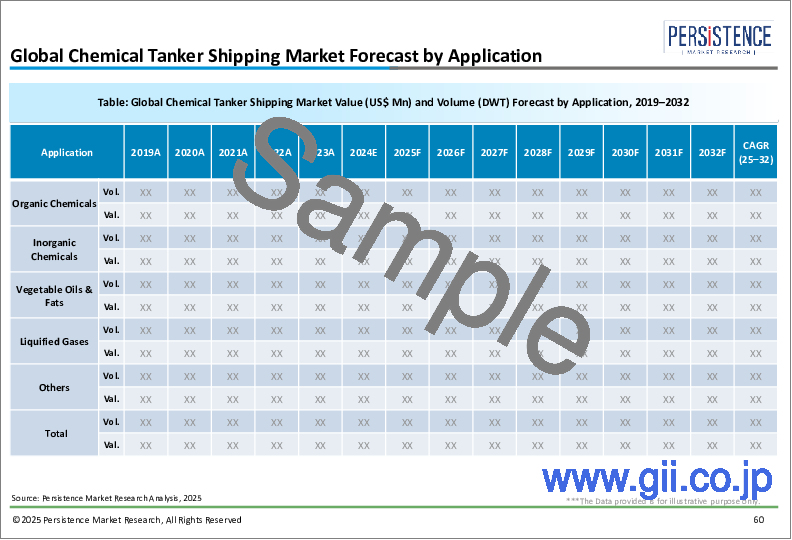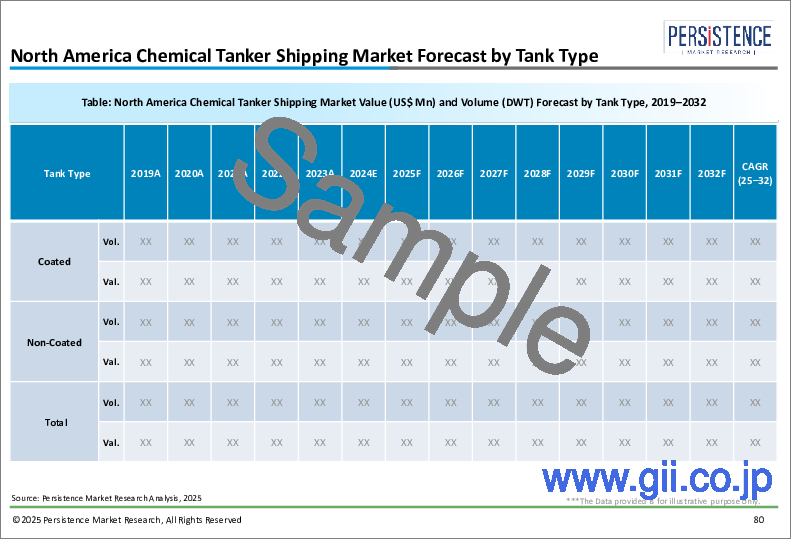|
|
市場調査レポート
商品コード
1713183
ケミカルタンカー輸送の世界市場:業界分析、規模、シェア、成長、動向、予測(2025年~2032年)Chemical Tanker Shipping Market: Global Industry Analysis, Size, Share, Growth, Trends, and Forecast, 2025 - 2032 |
||||||
カスタマイズ可能
|
|||||||
| ケミカルタンカー輸送の世界市場:業界分析、規模、シェア、成長、動向、予測(2025年~2032年) |
|
出版日: 2025年04月24日
発行: Persistence Market Research
ページ情報: 英文 150 Pages
納期: 2~5営業日
|
全表示
- 概要
- 目次
世界のケミカルタンカー輸送の市場規模は、2025年に377億7,000万米ドルになるとみられ、2025年~2032年の予測期間に4.5%のCAGRで拡大し、2032年には514億米ドルに達すると予測されています。
ケミカルタンカーは、液体化学品の海上輸送に使用される専用船です。これらの船舶には、危険、非危険、敏感な化学物質を取り扱うための高度な安全機能と貨物封じ込めシステムが装備されています。同市場には、IMOタイプ1、タイプ2、タイプ3タンカーなど、さまざまなタイプのケミカルタンカーがあり、さまざまな種類の化学物質や輸送ニーズに対応しています。
市場を牽引しているのは、医薬品、農業、自動車、消費財などの産業における化学品需要の増加と、世界の貿易要件を満たすための信頼性が高く安全な輸送ソリューションの必要性です。さらに、世界の化学品生産産業の継続的な成長と国際貿易の拡大は、市場拡大に寄与する主な要因です。
世界のケミカルタンカー輸送市場は、さまざまな産業における化学薬品需要の高まりなど、いくつかの重要な要因によって後押しされており、安全で効率的な輸送ソリューションに対するニーズの高まりにつながっています。特にアジア太平洋などの新興市場における化学製品の生産量の増加が、世界貿易を促進するケミカルタンカーの需要をさらに後押ししています。
強化された安全プロトコル、自動化、リアルタイムの貨物追跡など、タンカー設計の技術的進歩が業界の技術革新を促進しています。これらの開発は、運航効率、安全基準、燃費を改善し、市場開拓者がより厳しい規制要件や顧客の期待に応えるのに役立っています。
さらに、パンデミック後の世界経済の回復と国境を越えた貿易の増加が化学輸送の需要を押し上げ、市場成長の大きな機会となっています。
前向きな成長見通しにもかかわらず、ケミカルタンカー輸送市場はいくつかの課題に直面しています。主な障害のひとつは、先進的なタンカー船の購入と維持に必要な資本投資の高さです。さらに、排出基準やバラスト水処理などの厳しい環境規制は、より高価な技術を採用し、費用のかかるコンプライアンス手続きを遵守するよう事業者に圧力をかけています。
世界の原油価格の変動、燃料費の変動、運航経費の増加は、特に中小規模の船会社にとって、利益率へのさらなる課題となっています。市場はまた、パイプラインや鉄道などの代替輸送手段との競合にも直面しており、特定の地域における成長の可能性を制限する可能性があります。
ケミカルタンカー輸送市場は、技術の進歩、世界の景気回復、化学製品需要の増加によって大きな機会がもたらされます。低排出ガスやエネルギー効率のために設計されたタンカーなど、環境に優しいタンカーの導入は、市場参入企業に、拡大する持続可能性の動向に合わせ、規制圧力を遵守する道を提供します。
さらに、透明で安全な船積書類のためのブロックチェーンの使用や、ダウンタイムを削減するための予知保全システムなどのデジタル化の革新は、業務効率を高める機会を提供します。特殊化学品に対する需要の高まりや新興地域における新規市場の開発も、ケミカルタンカー輸送セクターのさらなる成長を促すと予想されます。
当レポートでは、世界のケミカルタンカー輸送市場について調査し、船体タイプ別、製品別、船体材質別、用途別、地域別動向、および市場に参入する企業のプロファイルなどを提供しています。
目次
第1章 エグゼクティブサマリー
第2章 市場概要
- 市場の範囲と定義
- 市場力学
- マクロ経済要因
- COVID-19の影響分析
- 予測要因- 関連性と影響
第3章 付加価値のある洞察
第4章 世界のケミカルタンカー輸送市場の見通し
- 主なハイライト
- 市場規模の分析と予測
- 過去の市場規模(10億米ドル)分析、2019年~2024年
- 現在の市場規模(10億米ドル)分析と予測、2025年~2032年
- 世界のケミカルタンカー輸送市場の見通し:船体タイプ別
- イントロダクション/主な調査結果
- 過去の市場規模(10億米ドル)分析、船体タイプ別、2019年~2024年
- 現在の市場規模(10億米ドル)分析と予測、船体タイプ別、2025年~2032年
- IMO 1
- IMO 2
- IMO 3
- 市場の魅力分析:フリートタイプ別
- 世界のケミカルタンカー輸送市場の見通し:製品別
- イントロダクション/主な調査結果
- 過去の市場規模(10億米ドル)分析、製品別、2019年~2024年
- 現在の市場規模(10億米ドル)分析と予測、製品別、2025年~2032年
- 内陸
- 沿岸
- 深海
- 市場の魅力分析:製品別
- 世界のケミカルタンカー輸送市場の見通し:船体材質別
- イントロダクション/主な調査結果
- 過去の市場規模(10億米ドル)分析、船体材質別、2019年~2024年
- 現在の市場規模(10億米ドル)分析と予測、船体材質別、2025年~2032年
- ステンレス鋼
- コーティング鋼
- 市場の魅力分析:船体材質別
- 世界のケミカルタンカー輸送市場の見通し:用途別
- イントロダクション/主な調査結果
- 過去の市場規模(10億米ドル)分析、用途別、2019年~2024年
- 現在の市場規模(10億米ドル)分析と予測、用途別、2025年~2032年
- 有機化学物質
- 無機化学品
- 植物油脂
- 液化ガス
- 市場の魅力分析:用途別
第5章 世界のケミカルタンカー輸送市場の見通し:地域別
- 主なハイライト
- 過去の市場規模(10億米ドル)分析、地域別、2019年~2024年
- 現在の市場規模(10億米ドル)分析と予測、地域別、2025年~2032年
- 北米
- 欧州
- アジア太平洋
- 南アジアとオセアニア
- ラテンアメリカ
- 中東・アフリカ
- 市場の魅力分析:地域別
第6章 北米のケミカルタンカー輸送市場の見通し
第7章 欧州のケミカルタンカー輸送市場の見通し
第8章 東アジアのケミカルタンカー輸送市場の見通し
第9章 南アジア・オセアニアのケミカルタンカー輸送市場の見通し
第10章 ラテンアメリカのケミカルタンカー輸送市場の見通し
第11章 中東・アフリカのケミカルタンカー輸送市場の見通し
第12章 競合情勢
- 市場シェア分析、2025年
- 市場構造
- 企業プロファイル(詳細- 概要、財務、戦略、最近の動向)
- Stolt-Nielsen
- Hafnia
- BASF
- MOL CHEMICAL TANKERS PTE. LTD
- Ardmore Shipping Corporation
- Odfjell
- Team Tankers International Ltd.
- Tokyo Marine Asia Pte Ltd.
- Bahri
- Navig8 Chemical Tankers
- MISC Berhad
- Ultrabulk
- Wilmar International
第13章 付録
Persistence Market Research has recently released a comprehensive report on the global chemical tanker shipping market. The report offers a detailed analysis of key market dynamics, including drivers, trends, opportunities, and challenges, while providing valuable insights into the market structure. This research publication presents exclusive data and forecasts the anticipated growth trajectory of the global chemical tanker shipping market from 2025 to 2032.
Key Insights:
- Chemical Tanker Shipping Market Size (2025E): USD 37.77 Billion
- Projected Market Value (2032F): USD 51.40 Billion
- Global Market Growth Rate (CAGR 2025 to 2032): 4.5%
Chemical Tanker Shipping Market - Report Scope:
Chemical tankers are specialized vessels used to transport bulk liquid chemicals across seas and oceans. These vessels are equipped with sophisticated safety features and cargo containment systems to handle hazardous, non-hazardous, and sensitive chemicals. The market encompasses various types of chemical tankers, including IMO Type 1, Type 2, and Type 3 tankers, catering to different types of chemicals and shipping needs.
The market is driven by increasing demand for chemicals in industries such as pharmaceuticals, agriculture, automotive, and consumer goods, as well as the need for reliable and safe transport solutions to meet global trade requirements. Additionally, the ongoing growth of the global chemical production industry and expanding international trade are key factors contributing to market expansion.
Market Growth Drivers:
The global chemical tanker shipping market is propelled by several key factors, including the rising demand for chemicals across various industries, which has led to a growing need for safe and efficient transportation solutions. Increasing chemical production, especially in emerging markets such as Asia Pacific, further supports the demand for chemical tanker vessels to facilitate global trade.
Technological advancements in tanker design, including enhanced safety protocols, automation, and real-time cargo tracking, are driving innovation in the industry. These developments improve operational efficiency, safety standards, and fuel consumption, helping market players meet stricter regulatory requirements and customer expectations.
Additionally, the recovery of global economies post-pandemic and the increase in cross-border trade have boosted the demand for chemical transportation, providing substantial opportunities for market growth.
Market Restraints:
Despite the positive growth prospects, the chemical tanker shipping market faces several challenges. One of the major obstacles is the high capital investment required to purchase and maintain advanced tanker vessels. Additionally, stringent environmental regulations, including emissions standards and ballast water treatment, are placing pressure on operators to adopt more expensive technologies and adhere to costly compliance procedures.
The volatility of global oil prices, fluctuating fuel costs, and increasing operational expenses further pose challenges to profit margins, particularly for small and medium-sized shipping companies. The market also faces competition from alternative transportation methods, such as pipelines and rail, which may limit growth potential in certain regions.
Market Opportunities:
The chemical tanker shipping market presents significant opportunities driven by technological advancements, global economic recovery, and increasing demand for chemical products. The introduction of eco-friendly tankers, including those designed for low emissions and energy efficiency, provides an avenue for market players to align with growing sustainability trends and comply with regulatory pressures.
Moreover, innovations in digitalization, such as the use of blockchain for transparent and secure shipping documentation and predictive maintenance systems to reduce downtime, offer opportunities to enhance operational efficiency. The growing demand for specialty chemicals and the development of new markets in emerging regions are also expected to drive further growth in the chemical tanker shipping sector.
Key Questions Answered in the Report:
- What are the primary factors driving the growth of the chemical tanker shipping market globally?
- How are technological advancements reshaping the operations and efficiency of chemical tanker vessels?
- Which regions are expected to experience the highest demand for chemical tanker shipping services?
- Who are the key players contributing to the growth of the chemical tanker shipping market, and what strategies are they using to maintain market relevance?
- What are the emerging trends and future prospects in the global chemical tanker shipping market?
Competitive Intelligence and Business Strategy:
Leading players in the global chemical tanker shipping market, such as Stolt-Nielsen Limited, Odfjell SE, and Mitsui O.S.K. Lines, focus on innovation, fleet expansion, and strategic partnerships to maintain a competitive edge. These companies invest heavily in new vessel technologies, including more fuel-efficient designs, eco-friendly fuel options, and advanced safety systems to improve fleet performance and meet regulatory standards.
Collaboration with chemical manufacturers, regulatory bodies, and port authorities is key to improving operational efficiency, enhancing safety measures, and ensuring compliance with evolving environmental and safety regulations. Furthermore, the adoption of digital tools such as route optimization software, cargo tracking systems, and predictive analytics is helping shipping companies streamline operations and reduce costs.
Key Companies Profiled:
- Hafnia
- BASF
- MOL CHEMICAL TANKERS PTE. LTD
- Stolt-Nielsen
- Ardmore Shipping Corporation
- Odfjell
- Team Tankers International Ltd.
- Tokyo Marine Asia Pte Ltd.
- Bahri
- Navig8 Chemical Tankers Inc.
- MISC Berhad
- Ultrabulk
- Wilmar International
Chemical Tanker Shipping Market Research Segmentation:
The chemical tanker shipping market encompasses various types of tankers, technologies, applications, and end-user segments.
By Product
- Inland
- Coastal
- Deep-sea
By Fleet Type
- IMO 1
- IMO 2
- IMO 3
By Fleet Material
- Stainless Steel
- Coated Steel
By Application
- Organic Chemicals
- Inorganic Chemicals
- Vegetable Oils & Fats
- Liquefied Gases
By Region
- North America
- Europe
- Asia Pacific
- South Asia and Oceania
- Latin America
- The Middle East and Africa
Table of Contents
1. Executive Summary
- 1.1. Global Chemical Tanker Shipping Market Snapshot, 2025-2032
- 1.2. Market Opportunity Assessment, 2025-2032, US$ Bn
- 1.3. Key Market Trends
- 1.4. Future Market Projections
- 1.5. Premium Market Insights
- 1.6. Industry Developments and Key Market Events
- 1.7. PMR Analysis and Recommendations
2. Market Overview
- 2.1. Market Scope and Definition
- 2.2. Market Dynamics
- 2.2.1. Drivers
- 2.2.2. Restraints
- 2.2.3. Opportunity
- 2.2.4. Challenges
- 2.2.5. Key Trends
- 2.3. Macro-Economic Factors
- 2.3.1. Global Sectorial Outlook
- 2.3.2. Global GDP Growth Outlook
- 2.4. COVID-19 Impact Analysis
- 2.5. Forecast Factors - Relevance and Impact
3. Value Added Insights
- 3.1. Regulatory Landscape
- 3.2. Pipeline Analysis
- 3.3. Product Adoption Analysis
- 3.4. Value Chain Analysis
- 3.5. Key Promotional Strategies by Manufacturers
- 3.6. PESTLE Analysis
- 3.7. Porter's Five Force Analysis
4. Global Chemical Tanker Shipping Market Outlook:
- 4.1. Key Highlights
- 4.1.1. Market Size (US$ Bn) and Y-o-Y Growth
- 4.1.2. Absolute $ Opportunity
- 4.2. Market Size (US$ Bn) Analysis and Forecast
- 4.2.1. Historical Market Size (US$ Bn) Analysis, 2019-2024
- 4.2.2. Current Market Size (US$ Bn) Analysis and Forecast, 2025-2032
- 4.3. Global Chemical Tanker Shipping Market Outlook: Fleet Type
- 4.3.1. Introduction / Key Findings
- 4.3.2. Historical Market Size (US$ Bn) Analysis, By Fleet Type, 2019-2024
- 4.3.3. Current Market Size (US$ Bn) Analysis and Forecast, By Fleet Type, 2025-2032
- 4.3.3.1. IMO 1
- 4.3.3.2. IMO 2
- 4.3.3.3. IMO 3
- 4.3.4. Market Attractiveness Analysis: Fleet Type
- 4.4. Global Chemical Tanker Shipping Market Outlook: Product
- 4.4.1. Introduction / Key Findings
- 4.4.2. Historical Market Size (US$ Bn) Analysis, By Product, 2019-2024
- 4.4.3. Current Market Size (US$ Bn) Analysis and Forecast, By Product, 2025-2032
- 4.4.3.1. Inland
- 4.4.3.2. Coastal
- 4.4.3.3. Deep-sea
- 4.4.4. Market Attractiveness Analysis: Product
- 4.5. Global Chemical Tanker Shipping Market Outlook: Fleet Material
- 4.5.1. Introduction / Key Findings
- 4.5.2. Historical Market Size (US$ Bn) Analysis, By Fleet Material, 2019-2024
- 4.5.3. Current Market Size (US$ Bn) Analysis and Forecast, By Fleet Material, 2025-2032
- 4.5.3.1. Stainless Steel
- 4.5.3.2. Coated Steel
- 4.5.4. Market Attractiveness Analysis: Fleet Material
- 4.6. Global Chemical Tanker Shipping Market Outlook: Application
- 4.6.1. Introduction / Key Findings
- 4.6.2. Historical Market Size (US$ Bn) Analysis, By Application, 2019-2024
- 4.6.3. Current Market Size (US$ Bn) Analysis and Forecast, By Application, 2025-2032
- 4.6.3.1. Organic Chemicals
- 4.6.3.2. Inorganic Chemicals
- 4.6.3.3. Vegetable Oils & Fats
- 4.6.3.4. Liquefied Gases
- 4.6.4. Market Attractiveness Analysis: Application
5. Global Chemical Tanker Shipping Market Outlook: Region
- 5.1. Key Highlights
- 5.2. Historical Market Size (US$ Bn) Analysis, By Region, 2019-2024
- 5.3. Current Market Size (US$ Bn) Analysis and Forecast, By Region, 2025-2032
- 5.3.1. North America
- 5.3.2. Europe
- 5.3.3. Asia Pacific
- 5.3.4. South Asia and Oceania
- 5.3.5. Latin America
- 5.3.6. Middle East & Africa
- 5.4. Market Attractiveness Analysis: Region
6. North America Chemical Tanker Shipping Market Outlook:
- 6.1. Key Highlights
- 6.2. Historical Market Size (US$ Bn) Analysis, By Market, 2019-2024
- 6.2.1. By Country
- 6.2.2. By Fleet Type
- 6.2.3. By Product
- 6.2.4. By Fleet Material
- 6.2.5. By Application
- 6.3. Current Market Size (US$ Bn) Analysis and Forecast, By Country, 2025-2032
- 6.3.1. U.S.
- 6.3.2. Canada
- 6.4. Current Market Size (US$ Bn) Analysis and Forecast, By Fleet Type, 2025-2032
- 6.4.1. IMO 1
- 6.4.2. IMO 2
- 6.4.3. IMO 3
- 6.5. Current Market Size (US$ Bn) Analysis and Forecast, By Product, 2025-2032
- 6.5.1. Inland
- 6.5.2. Coastal
- 6.5.3. Deep-sea
- 6.6. Current Market Size (US$ Bn) Analysis and Forecast, By Fleet Material, 2025-2032
- 6.6.1. Stainless Steel
- 6.6.2. Coated Steel
- 6.7. Current Market Size (US$ Bn) Analysis and Forecast, By Application, 2025-2032
- 6.7.1. Organic Chemicals
- 6.7.2. Inorganic Chemicals
- 6.7.3. Vegetable Oils & Fats
- 6.7.4. Liquefied Gases
- 6.8. Market Attractiveness Analysis
7. Europe Chemical Tanker Shipping Market Outlook:
- 7.1. Key Highlights
- 7.2. Historical Market Size (US$ Bn) Analysis, By Market, 2019-2024
- 7.2.1. By Country
- 7.2.2. By Fleet Type
- 7.2.3. By Product
- 7.2.4. By Fleet Material
- 7.2.5. By Application
- 7.3. Current Market Size (US$ Bn) Analysis and Forecast, By Country, 2025-2032
- 7.3.1. Germany
- 7.3.2. France
- 7.3.3. U.K.
- 7.3.4. Italy
- 7.3.5. Spain
- 7.3.6. Russia
- 7.3.7. Turkey
- 7.3.8. Rest of Europe
- 7.4. Current Market Size (US$ Bn) Analysis and Forecast, By Fleet Type, 2025-2032
- 7.4.1. IMO 1
- 7.4.2. IMO 2
- 7.4.3. IMO 3
- 7.5. Current Market Size (US$ Bn) Analysis and Forecast, By Product, 2025-2032
- 7.5.1. Inland
- 7.5.2. Coastal
- 7.5.3. Deep-sea
- 7.6. Current Market Size (US$ Bn) Analysis and Forecast, By Fleet Material, 2025-2032
- 7.6.1. Stainless Steel
- 7.6.2. Coated Steel
- 7.7. Current Market Size (US$ Bn) Analysis and Forecast, By Application, 2025-2032
- 7.7.1. Organic Chemicals
- 7.7.2. Inorganic Chemicals
- 7.7.3. Vegetable Oils & Fats
- 7.7.4. Liquefied Gases
- 7.8. Market Attractiveness Analysis
8. East Asia Chemical Tanker Shipping Market Outlook:
- 8.1. Key Highlights
- 8.2. Historical Market Size (US$ Bn) Analysis, By Market, 2019-2024
- 8.2.1. By Country
- 8.2.2. By Fleet Type
- 8.2.3. By Product
- 8.2.4. By Fleet Material
- 8.2.5. By Application
- 8.3. Current Market Size (US$ Bn) Analysis and Forecast, By Country, 2025-2032
- 8.3.1. China
- 8.3.2. Japan
- 8.3.3. South Korea
- 8.4. Current Market Size (US$ Bn) Analysis and Forecast, By Fleet Type, 2025-2032
- 8.4.1. IMO 1
- 8.4.2. IMO 2
- 8.4.3. IMO 3
- 8.5. Current Market Size (US$ Bn) Analysis and Forecast, By Product, 2025-2032
- 8.5.1. Inland
- 8.5.2. Coastal
- 8.5.3. Deep-sea
- 8.6. Current Market Size (US$ Bn) Analysis and Forecast, By Fleet Material, 2025-2032
- 8.6.1. Stainless Steel
- 8.6.2. Coated Steel
- 8.7. Current Market Size (US$ Bn) Analysis and Forecast, By Application, 2025-2032
- 8.7.1. Organic Chemicals
- 8.7.2. Inorganic Chemicals
- 8.7.3. Vegetable Oils & Fats
- 8.7.4. Liquefied Gases
- 8.8. Market Attractiveness Analysis
9. South Asia & Oceania Chemical Tanker Shipping Market Outlook:
- 9.1. Key Highlights
- 9.2. Historical Market Size (US$ Bn) Analysis, By Market, 2019-2024
- 9.2.1. By Country
- 9.2.2. By Fleet Type
- 9.2.3. By Product
- 9.2.4. By Fleet Material
- 9.2.5. By Application
- 9.3. Current Market Size (US$ Bn) Analysis and Forecast, By Country, 2025-2032
- 9.3.1. India
- 9.3.2. Southeast Asia
- 9.3.3. ANZ
- 9.3.4. Rest of South Asia & Oceania
- 9.4. Current Market Size (US$ Bn) Analysis and Forecast, By Fleet Type, 2025-2032
- 9.4.1. IMO 1
- 9.4.2. IMO 2
- 9.4.3. IMO 3
- 9.5. Current Market Size (US$ Bn) Analysis and Forecast, By Product, 2025-2032
- 9.5.1. Inland
- 9.5.2. Coastal
- 9.5.3. Deep-sea
- 9.6. Current Market Size (US$ Bn) Analysis and Forecast, By Fleet Material, 2025-2032
- 9.6.1. Stainless Steel
- 9.6.2. Coated Steel
- 9.7. Current Market Size (US$ Bn) Analysis and Forecast, By Application, 2025-2032
- 9.7.1. Organic Chemicals
- 9.7.2. Inorganic Chemicals
- 9.7.3. Vegetable Oils & Fats
- 9.7.4. Liquefied Gases
- 9.8. Market Attractiveness Analysis
10. Latin America Chemical Tanker Shipping Market Outlook:
- 10.1. Key Highlights
- 10.2. Historical Market Size (US$ Bn) Analysis, By Market, 2019-2024
- 10.2.1. By Country
- 10.2.2. By Fleet Type
- 10.2.3. By Product
- 10.2.4. By Fleet Material
- 10.2.5. By Application
- 10.3. Current Market Size (US$ Bn) Analysis and Forecast, By Country, 2025-2032
- 10.3.1. Brazil
- 10.3.2. Mexico
- 10.3.3. Rest of Latin America
- 10.4. Current Market Size (US$ Bn) Analysis and Forecast, By Fleet Type, 2025-2032
- 10.4.1. IMO 1
- 10.4.2. IMO 2
- 10.4.3. IMO 3
- 10.5. Current Market Size (US$ Bn) Analysis and Forecast, By Product, 2025-2032
- 10.5.1. Inland
- 10.5.2. Coastal
- 10.5.3. Deep-sea
- 10.6. Current Market Size (US$ Bn) Analysis and Forecast, By Fleet Material, 2025-2032
- 10.6.1. Stainless Steel
- 10.6.2. Coated Steel
- 10.7. Current Market Size (US$ Bn) Analysis and Forecast, By Application, 2025-2032
- 10.7.1. Organic Chemicals
- 10.7.2. Inorganic Chemicals
- 10.7.3. Vegetable Oils & Fats
- 10.7.4. Liquefied Gases
- 10.8. Market Attractiveness Analysis
11. Middle East & Africa Chemical Tanker Shipping Market Outlook:
- 11.1. Key Highlights
- 11.2. Historical Market Size (US$ Bn) Analysis, By Market, 2019-2024
- 11.2.1. By Country
- 11.2.2. By Fleet Type
- 11.2.3. By Product
- 11.2.4. By Fleet Material
- 11.2.5. By Application
- 11.3. Current Market Size (US$ Bn) Analysis and Forecast, By Country, 2025-2032
- 11.3.1. GCC Countries
- 11.3.2. Egypt
- 11.3.3. South Africa
- 11.3.4. Northern Africa
- 11.3.5. Rest of Middle East & Africa
- 11.4. Current Market Size (US$ Bn) Analysis and Forecast, By Fleet Type, 2025-2032
- 11.4.1. IMO 1
- 11.4.2. IMO 2
- 11.4.3. IMO 3
- 11.5. Current Market Size (US$ Bn) Analysis and Forecast, By Product, 2025-2032
- 11.5.1. Inland
- 11.5.2. Coastal
- 11.5.3. Deep-sea
- 11.6. Current Market Size (US$ Bn) Analysis and Forecast, By Fleet Material, 2025-2032
- 11.6.1. Stainless Steel
- 11.6.2. Coated Steel
- 11.7. Current Market Size (US$ Bn) Analysis and Forecast, By Application, 2025-2032
- 11.7.1. Organic Chemicals
- 11.7.2. Inorganic Chemicals
- 11.7.3. Vegetable Oils & Fats
- 11.7.4. Liquefied Gases
- 11.8. Market Attractiveness Analysis
12. Competition Landscape
- 12.1. Market Share Analysis, 2025
- 12.2. Market Structure
- 12.2.1. Competition Intensity Mapping By Market
- 12.2.2. Competition Dashboard
- 12.3. Company Profiles (Details - Overview, Financials, Strategy, Recent Developments)
- 12.3.1. Stolt-Nielsen
- 12.3.1.1. Overview
- 12.3.1.2. Segments and Products
- 12.3.1.3. Key Financials
- 12.3.1.4. Market Developments
- 12.3.1.5. Market Strategy
- 12.3.2. Hafnia
- 12.3.3. BASF
- 12.3.4. MOL CHEMICAL TANKERS PTE. LTD
- 12.3.5. Ardmore Shipping Corporation
- 12.3.6. Odfjell
- 12.3.7. Team Tankers International Ltd.
- 12.3.8. Tokyo Marine Asia Pte Ltd.
- 12.3.9. Bahri
- 12.3.10. Navig8 Chemical Tankers
- 12.3.11. MISC Berhad
- 12.3.12. Ultrabulk
- 12.3.13. Wilmar International
- 12.3.1. Stolt-Nielsen
13. Appendix
- 13.1. Research Methodology
- 13.2. Research Assumptions
- 13.3. Acronyms and Abbreviations






